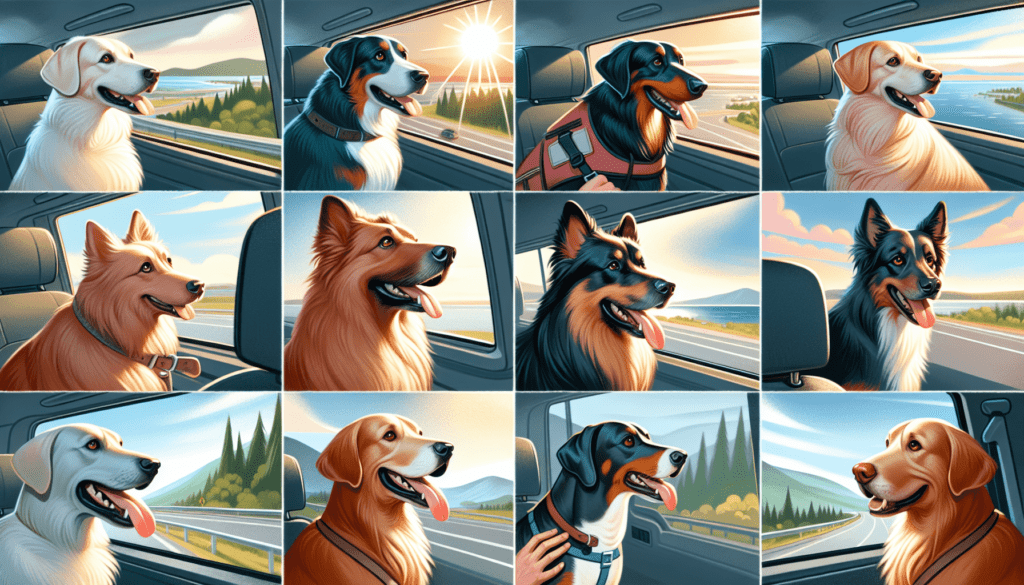Traveling with a nervous pup can be a stressful experience, but fear not! In this article, we will explore effective strategies to help your furry friend overcome their car rides or travel anxiety. From gradual exposure to positive reinforcement techniques, discover the tried and tested methods that will not only make your dog feel more comfortable on the road but also turn those once anxiety-inducing journeys into enjoyable adventures. So, let’s embark on this journey together and pave the way for a stress-free travel experience for both you and your four-legged companion. Car ride or travel anxiety is a common issue that many dogs experience. Whether it’s a fear of the unknown, negative past experiences, motion sickness, or separation anxiety, understanding the underlying causes is essential in addressing this issue. By identifying the symptoms of car ride or travel anxiety, you can better tailor your approach to helping your furry friend feel more comfortable during trips. Preparing your dog for car rides or travel is another crucial step that involves gradual desensitization, positive association with the car, creating a comfortable and safe space, and practicing short trips. Establishing a pre-trip routine that includes exercise, limiting food and water intake, providing potty breaks, and creating a relaxing atmosphere with lavender or chamomile scents can also help alleviate anxiety. Ensuring safety and security in the car is important, so using a secure dog crate or carrier, crash-tested harness, and avoiding loose objects and excessively loud noises are recommended. Keeping your dog occupied and distracted with chew toys, interactive treat-dispensing toys, favorite blankets, and training exercises can divert their attention from anxiety. Implementing positive reinforcement techniques, such as rewarding calm behavior and avoiding punishment or scolding, will also contribute to their overall well-being. When necessary, considering medication or natural remedies like consulting with a veterinarian for options, using natural supplements like chamomile or CBD oil, or trying anxiety wraps or Thundershirts can provide additional relief. Seeking professional training or assistance, like enrolling in car desensitization classes or working with a certified dog trainer or behaviorist, can offer guidance tailored to your dog’s unique needs. Gradually increasing travel distance and duration, starting with short trips and making frequent stops for breaks and exploration, can help your dog adapt to longer rides. Lastly, planning fun and rewarding destinations can create positive associations with car rides and enhance the overall experience for your furry friend.
Understanding the Causes of Car Ride or Travel Anxiety
Fear of the unknown can trigger anxiety in dogs when it comes to car rides or travel. The unfamiliar sights, sounds, and sensations they encounter can create a sense of unease. Negative past experiences, such as car accidents or trips to the veterinarian, can also contribute to anxiety. Motion sickness, which may result in nausea, dizziness, or even vomiting, can make dogs feel uncomfortable and anxious about getting into a car. Additionally, separation anxiety, when dogs become stressed and anxious due to being separated from their owners, can also manifest during car rides or travel.
Identifying Symptoms of Car Ride or Travel Anxiety
It’s essential to recognize the signs of car ride or travel anxiety in your dog so that you can address their needs appropriately. Panting and drooling excessively can indicate stress or discomfort. Restlessness and pacing are common behaviors displayed by anxious dogs in cars. Whining or barking may also be signs of anxiety, as dogs try to communicate their distress. Trembling or shaking can be physical manifestations of fear or anxiety. Loss of appetite and vomiting or diarrhea are additional symptoms that can occur due to stress or motion sickness.
Preparing Your Dog for Car Rides or Travel
Gradual desensitization is a key strategy in helping your dog overcome car ride or travel anxiety. Start by introducing them to the car in a positive and gradual manner, allowing them to explore and become familiar with the vehicle over time. Creating a comfortable and safe space in the car, such as using comfortable bedding or a secure crate, can make your dog feel more at ease. Practice short trips to nearby locations, gradually increasing the duration and distance to build their confidence. Calming aids like pheromone sprays or essential oils can also be used to create a relaxing atmosphere during car rides.
Establishing a Pre-Trip Routine
Establishing a pre-trip routine can help set a calm and relaxed tone for your dog before embarking on a car ride. Prior to the journey, ensure your dog gets enough exercise and mental stimulation to tire them out and reduce anxiety. Limit food and water intake before the trip to minimize the chances of motion sickness or accidents during the ride. Providing potty breaks before getting into the car will also help prevent any discomfort or accidents. Using lavender or chamomile scents in the car can have a soothing effect on your dog’s nerves.
Ensuring Safety and Security in the Car
Safety is paramount when it comes to traveling with your dog. Using a secure dog crate or carrier will not only keep your pet safe but also help them feel more secure during the journey. If your dog prefers to ride unrestrained, consider a crash-tested harness that attaches to the seatbelt, ensuring both safety and comfort. Avoid having loose objects in the car that can become projectiles during sudden stops or turns. Keeping the windows partially open can provide fresh air and eliminate any feelings of confinement or stuffiness. Additionally, avoid playing excessively loud music or noises, as they can add to your dog’s anxiety.
Keeping Your Dog Occupied and Distracted
To divert your dog’s attention from their anxiety, provide them with chew toys or puzzle toys that they can engage with during the trip. Interactive treat-dispensing toys can keep their minds occupied and provide a positive distraction. Offering their favorite blankets or comfort items that have familiar scents can also help create a sense of security. Playing calming music or audiobooks specifically designed for dogs can have a soothing effect on their nerves. Engaging in training exercises, such as basic commands or simple tricks, can mentally stimulate your dog and keep their focus away from anxious thoughts.
Implementing Positive Reinforcement Techniques
Positive reinforcement is a powerful tool in training and managing anxiety in dogs. Reward calm behavior in the car by offering treats or verbal praise, letting your dog know that they are doing well. Avoid punishment or scolding, as it can escalate your dog’s anxiety and create negative associations with car rides. Consistency and patience are key when using positive reinforcement techniques, as it may take time for your dog to feel more comfortable in the car.
Considering Medication or Natural Remedies
If your dog’s anxiety persists despite other interventions, consulting with a veterinarian can provide further insight and potential solutions. In some cases, medication may be prescribed to help alleviate anxiety during car rides or travel. Natural remedies such as chamomile or L-theanine supplements can also offer a calming effect on dogs. CBD oil, known for its anxiety-relieving properties, can be used under veterinary guidance. Anxiety wraps or Thundershirts, which provide a gentle, constant pressure around the body, can help reduce anxiety by promoting a sense of security.
Seeking Professional Training or Assistance
If your dog’s car ride or travel anxiety is severe or not improving with your efforts, seeking professional training or assistance can be beneficial. Enrolling in car desensitization classes can help your dog become more comfortable with car rides through structured training exercises. Behavioral modification techniques provided by professionals can address underlying causes of anxiety and develop strategies to manage and reduce it effectively. Working with a certified dog trainer or behaviorist can provide personalized guidance based on your dog’s specific needs, ensuring a comprehensive approach to tackling their anxiety.
Gradually Increasing Travel Distance and Duration
Once your dog starts to feel more comfortable with short trips, gradually increase the distance and duration of the rides. Start with trips around the block and gradually extend them to nearby destinations. Make frequent stops for breaks and exploration, allowing your dog to stretch their legs and relieve themselves. By planning fun and rewarding destinations, such as parks or pet-friendly locations, you can create positive associations with car rides and make the overall experience more enjoyable for your furry friend.
In conclusion, understanding the causes of car ride or travel anxiety in dogs is essential in addressing this issue. By identifying the symptoms and taking proactive steps to prepare your dog for car rides or travel, you can help alleviate their anxiety and make the experience more positive. Establishing a pre-trip routine, ensuring safety and security in the car, keeping your dog occupied and distracted, implementing positive reinforcement techniques, considering medication or natural remedies if needed, seeking professional training or assistance, and gradually increasing travel distance and duration are all important aspects to consider when helping your dog cope with car rides or travel anxiety. With patience, consistency, and a compassionate approach, you can support your furry friend in overcoming their anxiety and enjoying a stress-free travel experience.


